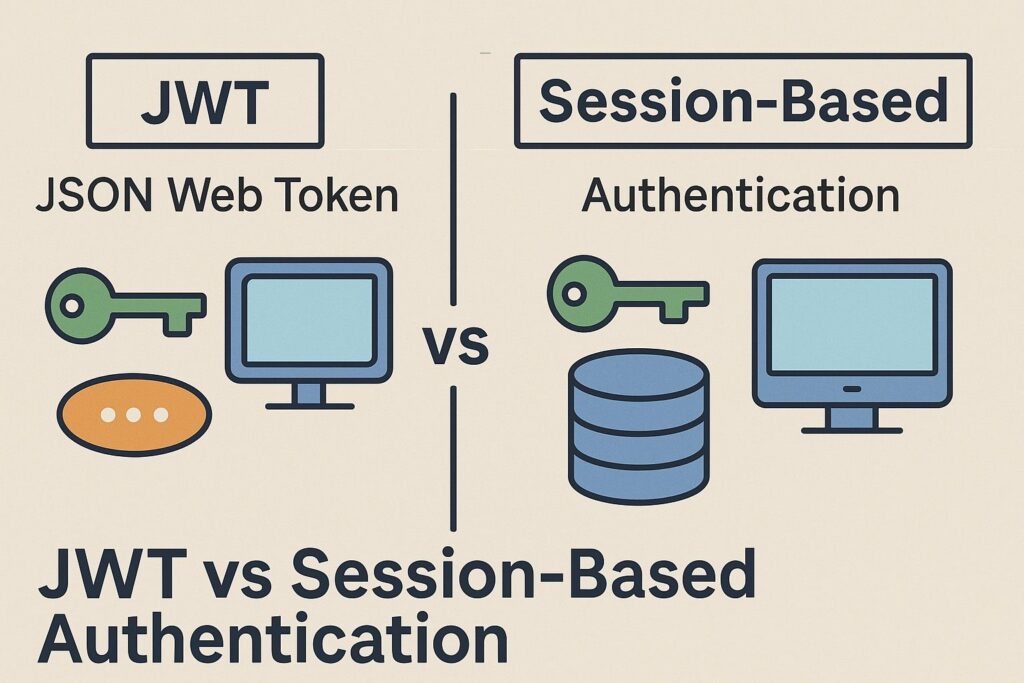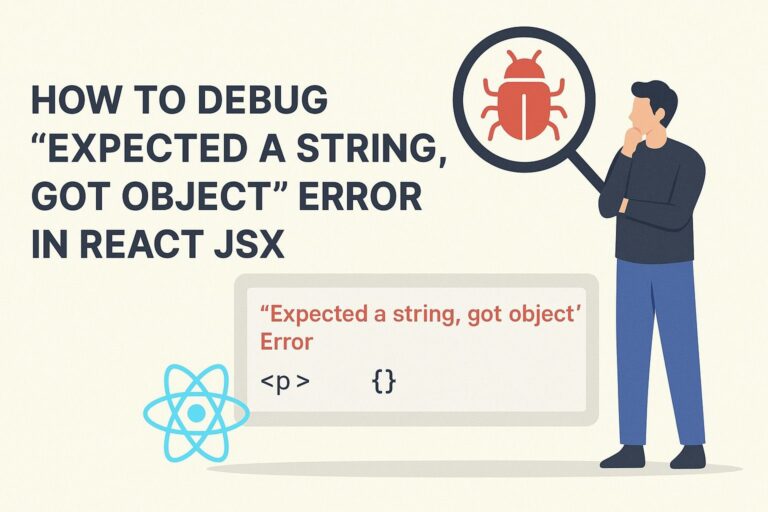
Authentication is one of the foundational elements of web application security. It verifies the identity of users and determines their access rights. In today’s web development landscape, two widely adopted methods for handling user authentication are Session-Based Authentication and JWT (JSON Web Token) Authentication.
While both serve the same fundamental purpose—ensuring only authenticated users can access protected resources—the way they handle authentication and session management is very different. Choosing the right method for your application depends on various factors such as scalability, security, performance, and architecture.
This in-depth guide walks through how each method works, compares their advantages and limitations, and highlights best use cases and security practices.
What is Session-Based Authentication?
Session-Based Authentication is a traditional and widely used method in which authentication information is stored on the server. Once a user logs in successfully, the server generates a unique session ID and stores it, along with the user’s information, in server-side memory or a session store such as Redis or a relational database.
The session ID is sent to the client, usually in a cookie. For every subsequent request, the client sends this session ID back to the server. The server verifies the session and allows access to protected resources based on the stored authentication data.
Step-by-Step Process
- The user submits login credentials to the server.
- The server verifies the credentials and creates a session in memory.
- A unique session ID is generated and sent to the client as a cookie.
- The client stores the session ID and automatically includes it in subsequent requests.
- The server retrieves the session data using the session ID and performs access control.
Server-Side Storage
The main feature of session-based authentication is that the session state is stored on the server. This makes it relatively easy to manage, revoke, or update sessions.
What is JWT-Based Authentication?
JWT (JSON Web Token) Authentication is a stateless authentication mechanism that uses self-contained tokens signed by the server. When a user logs in, the server creates a JWT, signs it using a secret or private key, and sends it to the client. The client stores the token (typically in localStorage or cookies) and sends it with each request, usually in the Authorization header as a Bearer token.
Unlike session-based authentication, the server does not store any session information. The token itself contains all the necessary claims and user data to verify the identity of the client.
Step-by-Step Process
- The user submits login credentials.
- The server validates the credentials and creates a JWT containing user data and claims.
- The server signs the token with a secret key and sends it to the client.
- The client stores the token and includes it in the
Authorizationheader on every request. - The server verifies the token signature and decodes its payload to authorize the request.
Token Payload
JWTs are made up of three parts: header, payload, and signature. The payload often includes:
- User ID
- Roles and permissions
- Token expiration (
exp) - Issuer (
iss) and audience (aud)
These claims allow for more flexible access control and decentralized verification.
Key Differences Between JWT and Session-Based Authentication
| Feature | Session-Based Authentication | JWT-Based Authentication |
|---|---|---|
| Storage Location | Session data stored on the server | Token stored on the client |
| State | Stateful | Stateless |
| Scalability | Requires centralized/shared session store | Scales easily across distributed servers |
| Performance | Requires session lookup on server | No lookup needed; token is self-contained |
| Revocation | Simple: remove session from store | Complex: requires blacklist or token expiration |
| Security Risks | Session hijacking, CSRF | Token theft, XSS |
| Storage Method | Usually via cookies | LocalStorage, sessionStorage, or cookies |
| Use in APIs | Not ideal for APIs | Ideal for RESTful APIs and microservices |
| Session Expiry | Server controlled (configurable timeout) | Client-controlled via exp claim |
| Token Size | Small (session ID only) | Larger due to payload |
| Access Control | Server checks permissions from session | Permissions often encoded in token claims |
Advantages of Session-Based Authentication
- Centralized Control: The server maintains full control over user sessions. Admins can invalidate sessions at any time.
- Fine-Grained Revocation: Sessions can be revoked easily and immediately by deleting them from the server.
- Simplicity: Easier to set up for basic applications that do not require complex infrastructure.
- Framework Support: Well-supported across all major web development frameworks like Django, Express, Laravel, and ASP.NET.
Limitations of Session-Based Authentication
- Scalability Constraints: Requires session data to be stored on a centralized server or a shared session store like Redis, which can be a bottleneck in distributed systems.
- Tight Coupling with Cookies: Usually tied to cookies for storage, which brings the need for CSRF protection.
- Server Load: As the number of users grows, session storage can consume significant memory or database resources.
- More Suited for Monolithic Apps: Not ideal for modern stateless architectures or API-first designs.
Advantages of JWT-Based Authentication
- Statelessness: No need for server-side storage of authentication state. Useful for serverless and microservice architectures.
- High Scalability: Easily scales across multiple services or servers because all authentication data is contained in the token.
- Better for APIs and SPAs: Works seamlessly with mobile apps, single-page applications, and cross-origin resource sharing (CORS).
- Built-in Expiration: Each token can have a predefined expiration time (
exp), reducing the need for manual session timeouts. - Role-Based Access: You can embed user roles and permissions directly into the token claims.
Limitations of JWT-Based Authentication
- Difficult Revocation: Once a token is issued, it remains valid until it expires. Revoking access before expiration requires complex strategies like blacklists or short-lived tokens with refresh tokens.
- Token Theft Risk: If stored insecurely (e.g., in localStorage), tokens are vulnerable to cross-site scripting (XSS) attacks.
- Larger Payload: JWTs contain user claims and metadata, which increases their size compared to simple session IDs.
- Token Replay: If a JWT is intercepted, it can be used until it expires, unless additional measures like rotating refresh tokens are implemented.
When to Use Session-Based Authentication
- You are building a traditional, server-rendered web application.
- Your application does not require cross-domain authentication.
- You want easy session invalidation or manual logout capability.
- Your infrastructure is centralized and does not require horizontal scaling.
- You prefer tighter server control over authentication state.
When to Use JWT-Based Authentication
- You are building a RESTful API, mobile app, or single-page application.
- Your backend is distributed across multiple services or serverless functions.
- You want stateless, scalable, and portable authentication.
- You need cross-domain authentication or OAuth-style delegated authorization.
- You want to reduce dependency on server-side storage for user sessions.
Security Best Practices
For Session-Based Authentication
- Use HTTPS to prevent session hijacking via packet sniffing.
- Regenerate session IDs after login to prevent fixation attacks.
- Implement CSRF protection if using cookies.
- Set session cookies with
HttpOnly,Secure, andSameSite=Strictattributes.
For JWT-Based Authentication
- Use short expiration times (
expclaim) to reduce token lifespan. - Implement refresh tokens for session continuity.
- Store tokens in
HttpOnlyandSecurecookies instead of localStorage when possible. - Do not store sensitive data like passwords or payment info in JWT payloads.
- Consider using rotating tokens or a token revocation list (blacklist).
Final Thoughts
Both JWT and session-based authentication are valid and widely adopted strategies. Each has unique strengths and trade-offs that make it better suited to specific use cases.
Session-based authentication offers better control and simplicity for server-rendered applications and traditional architectures. It is reliable and familiar, especially for developers accustomed to frameworks like Django or Express.
JWT-based authentication, on the other hand, provides scalability and flexibility for modern, API-centric applications. Its stateless nature aligns perfectly with microservices, SPAs, and mobile-first development.
Ultimately, your choice should align with your application’s architecture, performance requirements, and security considerations. In some cases, a hybrid approach—combining JWT for APIs and sessions for web interfaces—may provide the best of both worlds.

I’m Shreyash Mhashilkar, an IT professional who loves building user-friendly, scalable digital solutions. Outside of coding, I enjoy researching new places, learning about different cultures, and exploring how technology shapes the way we live and travel. I share my experiences and discoveries to help others explore new places, cultures, and ideas with curiosity and enthusiasm.






